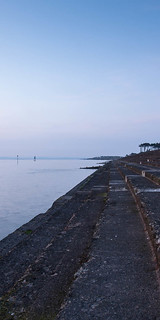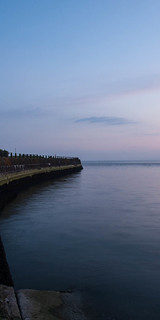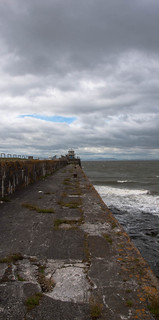Introduction – Background – Images – Lessons Learned – Assessment Criteria - Links
Introduction
Background
Images - Technical details
Lessons learned
Links and references
Introduction
The primary aim of this assignment is to produce a dozen photos in the style of the photographer I chose for Assignment 4.
The images presented here are taken from a developing series of images which allow me to investigate the varying forms which occur when the primary elements of our environment, whether man-made or natural, meet.
They also bring me back to the shoreline that featured in Assignment 3.
Background
As I discuss in my Learning Blog Hatakeyama adopts a range of styles, depending on subject matter, but a key linking feature for many of his series is his use of a relatively muted colour palette featuring mainly blues, greys, browns and greens – so this inevitably needs to be a key feature of this set. In order to achieve this I have had to shoot in relatively poor weather conditions, and often at twilight, both of which have the effect of limiting the range of colours and subduing the contrast and vibrance of the images.
I also propose to use a stylistic device he adopts for his Rivers series – using a panoramic format vertically, with a strong horizontal at the mid-point of the frame. In his case it was a practical consideration, but in my case I feel it fits the subject matter I have chosen – the transition zone between air, sea and land – the “edges” of our environment.
Also in line with Hatakeyama’s approach, although I find it quite comfortable for myself, is the idea of photography as an investigation, a way of understanding. The format provides a formal structure to set up a series of images where the visual meeting point of all three aspects is a single point, or small area, at the centre of the image – the “triple point” of the title, which is a loose reference to the physico-chemical triple point at which the vapour, liquid and solid phases all co-exist.
Images - Technical details
1: 1/160 @ f/14: ISO 200
2: 1/15 @ f/8: ISO 100
3: 1.3 @ f/13: ISO 100
4: 1.3 @ f/11 ISO 100
5: 1/125 @ f/18 ISO 100
6: 1/50 @ f/18 ISO 100
7: 1/50 @ f/18 ISO 100
8: 1/125 @ f/18 ISO 100
9: 1/80 @ f/18 ISO 100
10: 1/160 @ f/18 ISO 100
11: 1/30 @ f/8 ISO 100
12: 1/5 @ f/8 ISO 100
Lessons learned
Concept: In identifying a style it was important not to simply copy the content of Hatakeyama’s work as well – there is a clear separation between the two.Assessment criteria
I had one or two false starts before identifying a subject which both interested me, and would lend itself to elements of the chosen style, so there is obviously a linkage between subject and style. This is borne out by some of the debate about Salgado’s work on We Are OCA
Planning: Once I had established a style and a subject it was a matter of choosing conditions and locations which gave me a reasonable chance of delivering the subject in the chosen style.
Research: There was limited research required for this assignment as much of it was completed during Assignment 4
Technical and Visual Skills:
I believe I have identified a style and format that allows me to present the subject of interest to me in a way which emphasises the interaction of the various parts of our environment on the shoreline.
Quality of Outcome:
I have made much more use of a tripod during the production of this series, which has had the benefit of slowing down my approach to meet the demands of a very formal composition. The only times I have not done this have been when , because of my position I would risk losing my tripod and camera in the sea – for example, in some of the harbour wall shots, where there was no barrier between myself and the drop.
Overall I believe that giving the nature of the scenes I have achieved the formality well. The horizontals are perhaps less prominent than Hatakeyama’s, but that is at least in part due to the subject matter e.g. grass, rock armour and in part due to the sometimes precarious location.
Overall my choice of shooting condition has enabled me to make a good attempt at reproducing the colour palette and lighting conditions of my chosen style.
Creativity:
I have moved away from landscape photography as a simple portrayal of beauty to its use as a tool for studying subjects of interest. In doing so I have started to develop a typography of air/sea/land interfaces which, as with my wave studies in Assignment 3, offers potential for continuing development.
Context:
Series works feature quite strongly in contemporary photography. In this context Hatakeyama is an obvious example, but I can also see parallels in this series with Bialobrzeski’s Rungholt series, and also the cliff fall work of Jem Southam. They also share some of the formalism of Billingham’s Fenland landscapes.
It is certainly the case the prior to starting this course I would not have contemplated this approach to a photographic investigation.
Links and references
Learning Blog
Bialobrzeski, P in Vanishing Landscapes: Ed. Barth, N; Pub. Frances Lincoln; 2008
Southam, J in Vanishing Landscapes: Ed. Barth, N; Pub. Frances Lincoln; 2008
Billlingham, R; Landscapes 2001 – 2003; Pub. Dewi lewis Publishing; 2008
Hatakeyama, N: Lime Works; Pub. Amus Arts Press; 2002
Hatakeyama, N: Terrils; Pub. Editions Light Motiv; 2011
Galerie Luther Albrecht:
 |
 |
 |
 |
| Figure 1 | Figure 2 | Figure 3 | Figure 4 |
 |
 |
 |
 |
| Figure 5 | Figure 6 | Figure 7 | Figure 8 |
 |
 |
 |
 |
| Figure 9 | Figure 10 | Figure 11 | Figure 12 |
Yes, typologies, that came to me from the images before reading the text. Having the images gridded really emphasises it. This is a sophisticated place to have landed on from your early beginnings and clearly demonstrates progression in my view. Excellent.
ReplyDelete